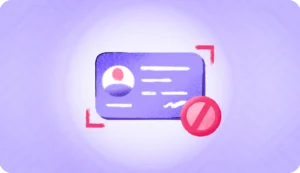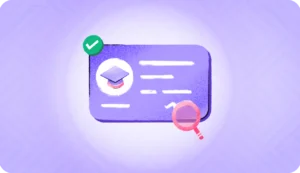Ever since the act of 1984 in the USA that puts the legal drinking age at 21, a lot of teenagers have been trying to get hold of fake IDs. While a duplicate ID wasn’t always comparable to its original counterparts and would be detected in fake ID verification, in recent years it has become increasingly difficult even humanly to tell the difference between them. What’s making this possible are the access to high-quality printers and scanners in homes, advanced photo editing software, and of course fake ID markets. The Internet also probably has directions somewhere that explain how to create a fake ID all by yourself. This means that fake ID verification also needs to be more prevalent.
And where and how to identify these fake IDs? A form of identity verification (combining OCR and face recognition) can be done to identify fake IDs. This could be at an airport where a passport is presented, at a customer onboarding screen where an Aadhaar is presented, or at a bank where fake details are provided to avail a loan. The use cases are many, and this makes tracking them down even more of a problem.
The COVID-19 pandemic saw several businesses move to a customer onboarding process that is completely online and digital, and in many cases completed even without human intervention. The accuracy of AI and the recent advancements in cloud technologies actually made this possible. The move to the cloud also meant that excess traffic was welcome to both apps and websites and organizations could scale very well to accommodate more and more customers. This means that more and more people have come to expect organizations to serve them in this manner.
What has also proliferated is the number of frauds, especially insurance and credit card frauds. These involve the use of fake photos and information, complete with duplicate QR codes. In such a scenario, it is important to have highly accurate OCR and face recognition during the customer onboarding processes and at other checkpoints that need identity verification. This will help keep the miscreant out of a secure system for good, while still allowing other users access despite a very strong fake ID verification.
Read more about document forgery here.
The ID that is generally used across countries and that every country mandates for travel is the passport. All countries use a passport as a verifying document for air travel at the port of embarkation as proof of identity. The other most frequently used valid IDs are:
Aadhaar: The Aadhaar is used by the Indian government and all Indian citizens are legally required to have one. The Aadhaar is used by several FinTech apps in India to verify identity and as proof of address. The equivalent of the Aadhaar is the National ID card in France. Bangladesh, Argentina, Albania, and Belgium are some of the countries that have a compulsory national ID card that is issued to all their citizens. There is no official national ID in the USA, and no authority issues this, though the Social Security Number and state-issued IDs serve as IDs for proof of identity.
Driver’s license: A driver’s license is a proof of identity that supports the fact that you have cleared the driving test in a country and that you are now capable and legally allowed to drive. It is generally gated by age and other physical characteristics. Most countries in the world have a driver’s license.
Voter ID: A voter ID is proof of the fact that you are legally of age to vote. While it has been enforced by the Election Commission and used in India, it has just been enforced in the UK. Earlier, all that was needed was a valid photo ID. In the US, there is still no voter ID, though the electoral process still requires a photo ID of some sort. This could be a state-issued ID, a military ID, or a driver’s license.
PAN Card: The permanent account number is an alphanumeric number issued to Indian nationals to track the income taxes and other financial obligations that they must bear. Thieves often duplicate it to bypass fake ID verification and gather access to data. In the UK, such a card does not exist and nationals or residents have a 10-digit UTR (Unique tax reference) associated with tax payments. In the US, the reference is the social security number. In France, the equivalent is the SIREN, a number that is proof of the fact that you are a registered taxpayer or a taxpaying business in France.
There are several types of fake IDs that are currently used. A classification is attempted below based on government guidelines:
Borrowed ID: A document that is genuine but used by someone else, with or without the person’s permission. An example is a brother using a sister’s driver’s license or voter ID.
Altered ID: An ID that has minor alterations to certain details but is otherwise genuine. An example of this is a driver’s license where the date has been altered to gain access to a bar or pub.
Stolen ID: This includes anything that is original and genuine but is used by someone else without any alterations. An example could be using another’s PAN number to register on an app.
Duplicate ID: A document that is an exact replica of another’s. An example would be a fake driver’s license used to register on an app, which prevents the original owner from ever being able to use it as the system detects a duplicate on signup.
Imagined ID: This includes fake documents that aren’t real but are used nevertheless as a form of identification, especially in apps that require human verification and that do not list any one type of ID as mandatory.
How Valid is your ID?
There are several IDs that may be considered valid in the digital world. The validity of an ID as proof varies from country to country and sometimes from state to state. Again how valid an ID is also depends on the use case and the purpose that it serves as proof. For instance, in India, the Aadhaar is accepted as an ID proof by almost every application, but we cannot say the same for the voter ID. The voter ID may or may not be valid in a FinTech app, where an Aadhaar is considered perfectly valid.
Now let us look at how fake ID verification works:
From the background
Particularly in modern times, the IDs are very sophisticated and are arrived at with advanced image processing and printing. This makes fake IDs more challenging to produce. An ID background cannot be easily duplicated, not even with professional photo editing software like Photoshop.
From holographic elements
Modern IDs have holographic elements which are again tough to reproduce and require special equipment for identifying and printing. An example is that of the driver’s license in the UK. There is a hologram of a steering wheel that is positioned directly over the driver’s photograph, and which turns as you move the card. This is quite remarkable and very difficult to replicate.
Personal info will be different
No matter how well the ID is reproduced, personal info on the ID card would be different or there would be little correlation between them. This is how you can identify a fake ID. A 1:N match against the original ID from a government database will reveal the inconsistencies and help spot a fake.
Closing words
Fraudsters have a knack for picking just the right information to successfully duplicate an ID to create a fake ID. Fraud detection and reliable identity verification solutions from HyperVerge are up to the match and could easily foil their attempts at a breach. AI is also helping with identity verification with incredible accuracy allowing for customer onboarding at scale on several apps. It is a never-ending battle but in the end, everyone is well-equipped to fight.
HyperVerge is an expert in fraud detection and document verification. Sign up to get a demo.
FAQs
1. What are other ways to spot a fake ID?
1. There would be air gaps and bumps on the ID because it has been laminated unprofessionally. 2. There are ragged or square edges 3. There are misspellings.
2. What is the punishment for a fake ID in India?
Fake IDs are punishable under IPC 420 with up to 7 years of imprisonment.
3. What is a ghost image on an ID?
A ghost image on an ID is a semi-translucent copy of the photo on an ID. It is visible on the ID and acts as an additional security measure.
4. Do all countries have a national ID card?
No, several countries have no national ID. Like many other countries, Australia tried to introduce a national ID card in 2006, but this did not follow through. At present, they have no national ID card. Japan is another country without a national ID card.





